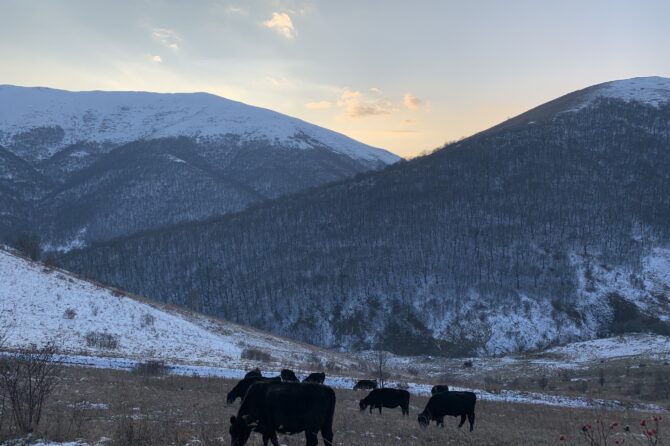
Winter Pasture Stockpiling
Turning Cold Seasons Into an Asset
For many mountain farmers, winter has always felt like the season that reduces possibilities — when pastures fall silent, barns strain under the weight of hay bales, and the rhythm of the farm slows under the burden of feeding costs. But a quiet transformation has been taking place in cold regions around the world. Farmers have begun to wonder whether winter could be an ally rather than an obstacle. This idea became the foundation of one of the most regenerative grazing systems in modern livestock farming: winter pasture stockpiling.
The Idea Behind Stockpiling
The principle is beautifully simple. Instead of grazing pastures through late summer and fall, farmers allow the land to rest. As the air cools, grasses shift from fast growth to energy storage, preparing themselves for the dormant season. Frost becomes a natural preserver. Instead of decaying, the grasses hold their structure, keeping their sugars and nutrients locked inside. By winter, the field becomes a standing reserve of preserved forage — nature’s own haystack, created without machines, fuel, or labor.
The Grasses That Withstand the Cold
Only certain grasses can endure the weight of frost and remain upright when snow arrives. Tall fescue often leads the way, known for its winter strength and late-season nutritional value. Orchardgrass maintains good fall regrowth, while timothy, bluegrass, clovers, and native mountain meadow species also play their role in building a resilient winter pasture. These plants remain intact long after other species collapse, offering clean, nutritious feed when it is needed most.
The Quiet Turning Point
Everything hinges on a single decision made in late August or early September. When grazing stops during this period, cool-season grasses use the remaining autumn warmth to regenerate and fill their roots with energy. The farmer, in return, harvests a form of winter feed simply by waiting. What grows in September becomes the foundation for December and January.
The Unexpected Quality of Winter Forage
Farmers experiencing stockpiling for the first time are often surprised at how sweet the winter forage becomes. Unlike hay, which loses color and nutrients when cut, dried, and stored, stockpiled grass is preserved by cold weather. Protein levels remain respectable, energy stays stable, and after the first frost, the natural sugars concentrate, making the forage even more palatable. In the clean winter air, animals relish this preserved feed.
Livestock Know How to Graze the Snow
Watching livestock graze stockpiled pasture in winter reveals how naturally the system fits them. Angus cattle push aside snow with their broad noses. Dorper sheep delicately nibble between frozen stems. Both species, especially those adapted to mountainous climates, thrive in these conditions. Farmers often guide them with strip or block grazing, allowing animals to move gradually across the pasture, making efficient use of the standing forage.
A Regenerative System at Its Core
Winter stockpiling is more than a feeding method — it is a blessing for the land. When fields remain covered with standing forage all winter, the soil is insulated, erosion is prevented, and moisture is retained. Organic matter rises, carbon stays in the ground, and spring arrives with fields that recover faster and stronger.
Healthier Animals, Healthier Farmers
Winter grazing reshapes life on the farm. Animals breathe crisp outdoor air and stay active instead of crowding around hay feeders. Their movement keeps them healthy, their rumen function improves, and parasite pressure decreases dramatically. Meanwhile, farmers spend less time hauling hay and more time observing the gentle, natural flow of winter grazing.
Challenges Worth Mentioning
Winter brings its own character, and stockpiling demands awareness. Water must remain available or snow must be clean enough for the animals to use. Ice can occasionally limit access to forage. Fencing must be reliable. Enough forage must always be left standing to ensure the pasture recovers in spring. These challenges, though real, are manageable with preparation and experience.
A New Way to Think About Winter
Farmers who adopt winter stockpiling often say the same thing: they had no idea how much money winter was costing them until they learned to let the land work for them. Winter becomes a season of natural abundance rather than financial strain. Livestock graze with calm persistence, following behaviors their ancestors practiced for thousands of years.
Epilogue: A Note from Mountain High Farms
These principles are universal, but they find a special home in the high mountain landscapes of Armenia’s Dilijan National Park. At Mountain High Farms, winter stockpiling stands at the heart of a year-round regenerative grazing system for Black Angus cattle and Dorper sheep. The clean alpine environment preserves nutrients naturally, creating exceptional winter forage and producing remarkably high-quality beef and lamb — raised simply, sustainably, and beautifully in harmony with the land.
Written by Ashot Boghossian
For Mountain High Farms



Leave a reply